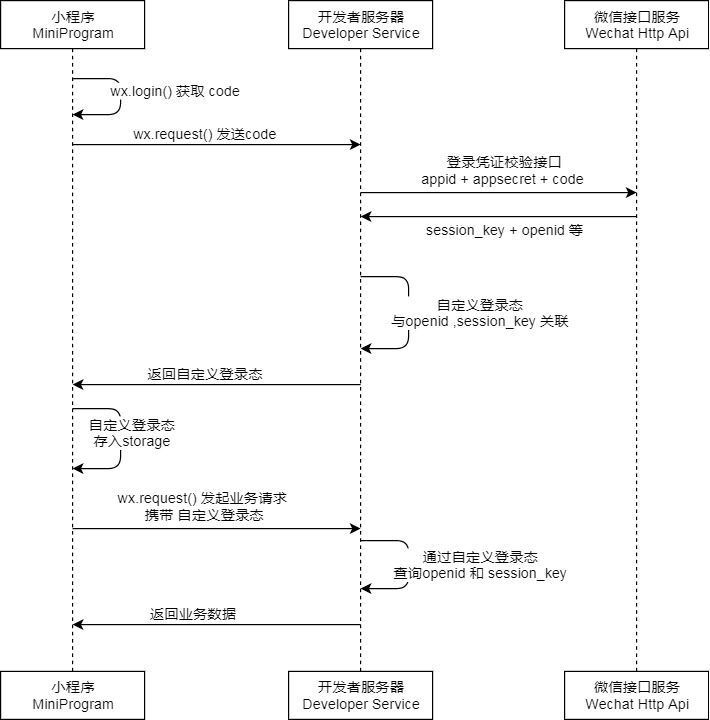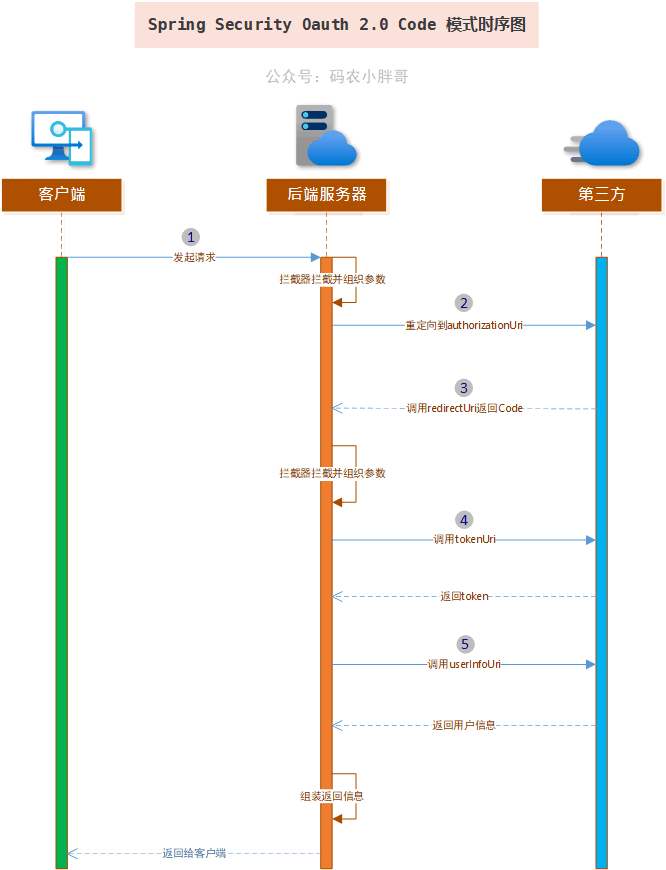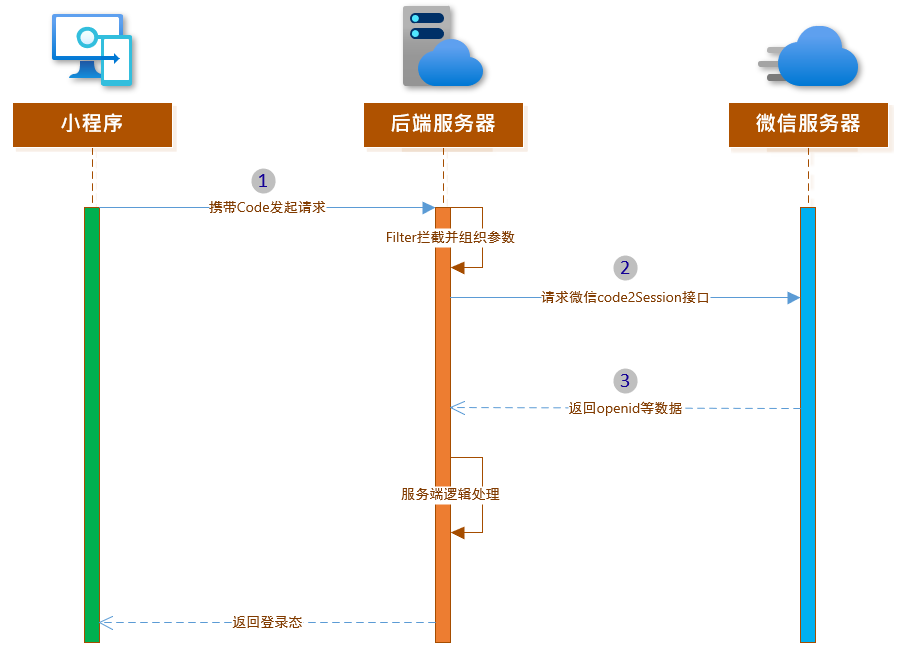
1. 前言
原本打算把Spring Security中OAuth 2.0的机制讲完后,用小程序登录来实战一下,发现小程序登录流程和Spring Security中OAuth 2.0登录的流程有点不一样,就把写了半天的东西全部推翻了。但是,但是过了一天之后,突然感觉又可以了。我们来一起试一试。
2. 小程序登录流程分析
小程序的登录流程是这样的:

而在Spring Security中的OAuth 2.0 Code模式是这样的:

从这两张图上看最大的差别就是微信小程序中获取code不需要通过后端服务器的调用,而Spring Security中需要(第1步,第2步,第3步)。腾讯应该也是借鉴了OAuth 2.0,但是做了一些改动。
让我放弃的也是这个差别,有没有人能想到解决方法呢?
假如说小程序已经持有了code,它依然需要将code传递给后端服务器来执行后面的流程。那么我们能不能利用图2中第3个调用redirectUri的步骤呢?换个角度来看问题第三方就是小程序反正它也是将一个code传递给了后端服务器,只要返回登录状态就行了,反正剩下的登录流程都跟小程序无关。我觉得它是可以的。在Spring Security中我们可以使用code通过tokenUri来换取token。那么在微信小程序登录流程中,code最终换取的只是登录态,没有特定的要求。但是后端肯定需要去获取用户的一些信息,比如openId,用户微信信息之类的。总之要根据微信平台提供的API来实现。通过改造tokenUri和userInfoUri可以做到这一点。
3. 思路借鉴
所有的猜想都没有错,而且我也实现了,但是改造成本过高了,写了很多兼容性的代码,如果不深入Spring Security,很难实现这,而且也不好理解。
为了简化实现,我决定借鉴Spring Security中OAuth 2.0的思路。Filter拦截小程序登录URL,然后通过RestTemplate执行向微信服务器请求获取结果,处理后返回登录态。时序图如下:

对应的伪代码实现:
package cn.felord.spring.security.filter;
import org.springframework.http.ResponseEntity;
import org.springframework.security.web.util.matcher.AntPathRequestMatcher;
import org.springframework.security.web.util.matcher.RequestMatcher;
import org.springframework.util.Assert;
import org.springframework.util.LinkedMultiValueMap;
import org.springframework.util.MultiValueMap;
import org.springframework.web.client.RestTemplate;
import org.springframework.web.filter.OncePerRequestFilter;
import org.springframework.web.util.UriComponentsBuilder;
import javax.servlet.FilterChain;
import javax.servlet.ServletException;
import javax.servlet.http.HttpServletRequest;
import javax.servlet.http.HttpServletResponse;
import java.io.IOException;
import java.net.URI;
/**
* 小程序登录过滤器
*
* @author felord.cn
* @since 1.0.4.RELEASE
*/
public class WeChatAppLoginFilter extends OncePerRequestFilter {
private final RequestMatcher requiresAuthenticationRequestMatcher;
private final RestTemplate restTemplate;
private String appId;
private String secret;
private static final String WX_URL = "https://api.weixin.qq.com/sns/jscode2session";
public WeChatAppLoginFilter(String loginProcessingUrl, String appId, String secret) {
this.appId = appId;
this.secret = secret;
Assert.notNull(loginProcessingUrl, "loginProcessingUrl must not be null");
this.requiresAuthenticationRequestMatcher = new AntPathRequestMatcher(loginProcessingUrl, "POST");
this.restTemplate = new RestTemplate();
}
@Override
protected void doFilterInternal(HttpServletRequest request, HttpServletResponse response, FilterChain filterChain) throws ServletException, IOException {
// 拦截微信登录
if (requiresAuthenticationRequestMatcher.matches(request)) {
//todo 从request中获取 code 参数 这里逻辑根据你的情况自行实现
String jsCode = "你自行实现从request中获取";
//todo 必要的校验自己写
MultiValueMap<String, String> queryParams = new LinkedMultiValueMap<>();
queryParams.add("appid", this.appId);
queryParams.add("secret", this.secret);
queryParams.add("js_code", jsCode);
queryParams.add("grant_type", "authorization_code");
URI uri = UriComponentsBuilder.fromHttpUrl(WX_URL)
.queryParams(queryParams)
.build()
.toUri();
//todo 这里 Object 自行封装为具体对象
ResponseEntity<Object> result = this.restTemplate.getForEntity(uri, Object.class);
//todo 处理 result 比如后端存储、后端授权、角色资源处理、注册、对session_key的处理等等你需要的业务逻辑
// 最后放入HttpServletResponse中返回前端返回
} else {
filterChain.doFilter(request, response);
}
}
}
最后一定别忘了把过滤器配置到WebSecurityConfigurerAdapter的HttpSecurity中去。
4. 总结
本篇讲解了Spring Security和微信小程序登录相结合的思路历程。本来不需要长篇大论OAuth 2.0,之所以写出来是让你明白开发中要善于发现一些相似的东西,通过差异对比来探讨他们结合的可能性,这也是一种自我提升的方法。方法远比结果重要,形成自己的方法论就能富有创造力。我是:码农小胖哥,多多关注,分享更多原创编程干货。
关注公众号:Felordcn 获取更多资讯